Menu
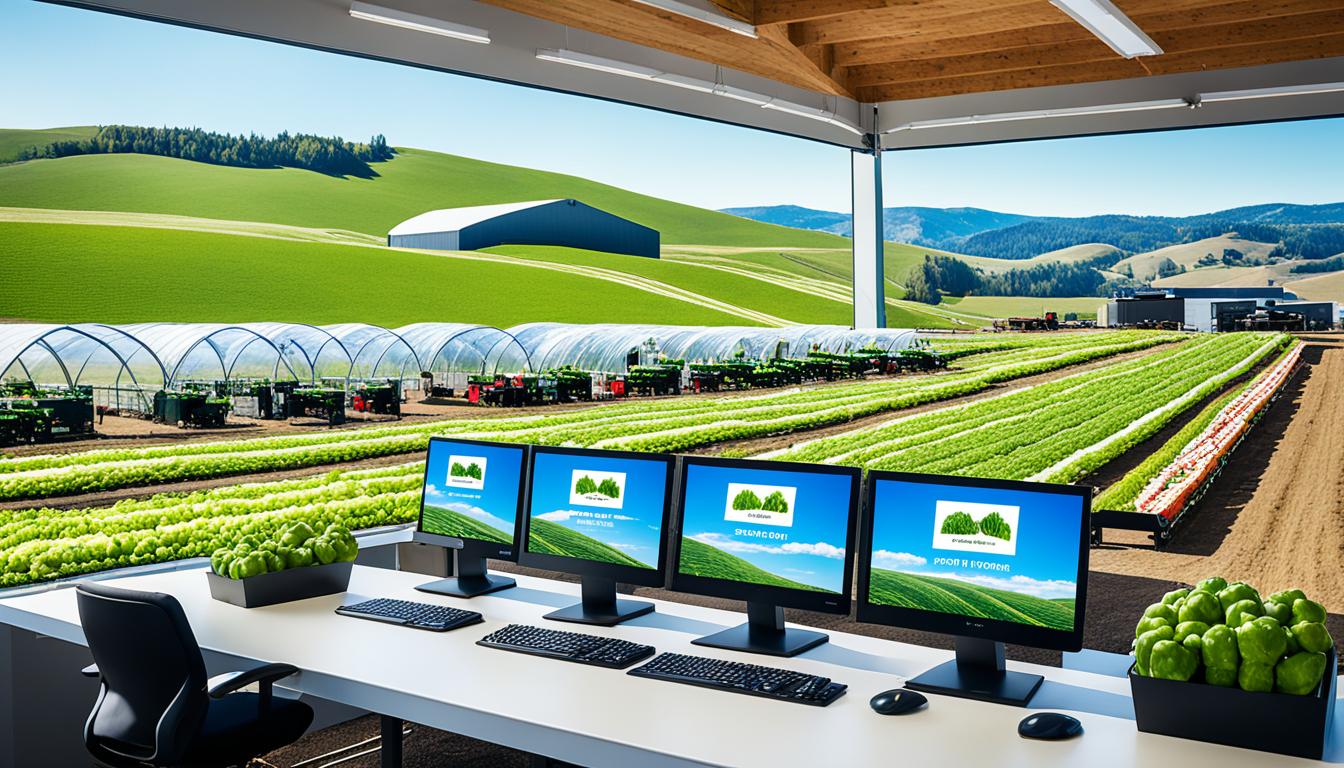
Farms offering direct delivery make twice as much in monthly sales. In today’s world, having an online store is essential. It helps you make more money and reach more people. Most buyers, about 93%, like to order online without help. So, it’s key to meet their needs.
An ecommerce agricultural business makes your brand stand out. It keeps customers coming back. By showing your farm’s goods online, you help people notice and buy them. Our detailed guide covers everything you need for a powerful website. This includes knowing your customers, smoothly managing orders with Barn2Door, and saving time with automation. Farms using this save over 2 hours every week.
To succeed in rural entrepreneurship, you must consider a few things. These include understanding who your customers are, organizing your website well, picking a good domain, choosing the right web platform, creating a catchy design, and keeping up with SEO. More than 70% of Americans like to pick up their online orders while out. This shows how important it is to offer different ways for them to get their goods.
Today’s world is all about being digital. So, having an online space for your farm is key. This way, you can grow and stay strong. Using e-commerce and digital marketing lets you tell more people about your farm. It also helps in selling directly to folks and pushes for eco-friendly farming.
Having a strong link between your farm and customers is great. It makes everything clear and easy. The upside? It brings you closer to the people buying your goods.
Selling online is a game-changer for farms of all sizes. It means fewer steps between you and your customers. This can lead to more earnings for you and better prices for them.
Online, you can:
But, there are some things to think about. Stuff like credit card fees (about 3% of your sales) and ad costs on social media (5% extra on Instagram for shipped orders). Plus, setting up your online shop might take a little time to learn. Still, the good points usually win over these small challenges.
Being visible online is super important. It helps more people find out about your farm. Setting up shop online means you can reach a lot of new faces. And not just any people – the ones looking for what you offer.
Using Google, Facebook, Instagram, and NextDoor helps. They let a wide range of people know about you. Having a Google profile also helps locals looking for farms like yours. They can find you easily and visit.
“A strong online presence is key to driving traffic to your purchasing platforms, broadening both your reach and customer base.”
Getting started with a free, simple website is a smart move. Platforms like Google Sites or Carrd can do wonders. Adding a point-of-sale system makes it easy for people to buy from you.
To really make e-commerce work for you, think about teaming up with other farms or using places like Etsy or eBay. Working with others can help you get your goods to more people.
Staying in touch with your customers is vital. Whether it’s by email or on social media, do it often. And always make sure your online store works smoothly before you start. A good online shop can lead to a great future in eco-friendly farming.
It’s key to know who you want to reach and why with your online farm store. Are you aiming to push forward eco-farming, share your farm’s special tale, or sell your harvest? These goals set your online step.
Pinpoint your buyers by thinking who might like your goods. Look at their age, what they earn, where they live, and what they like. This shows where to offer your stuff, be it at markets or by the road. Then, use these findings to smartly use the web.
Knowing what’s wanted and what you’ve not got enough of matters. Low supply in big demand areas needs less hype. Yet, lining up against other growers or shops takes some planning to stand out.
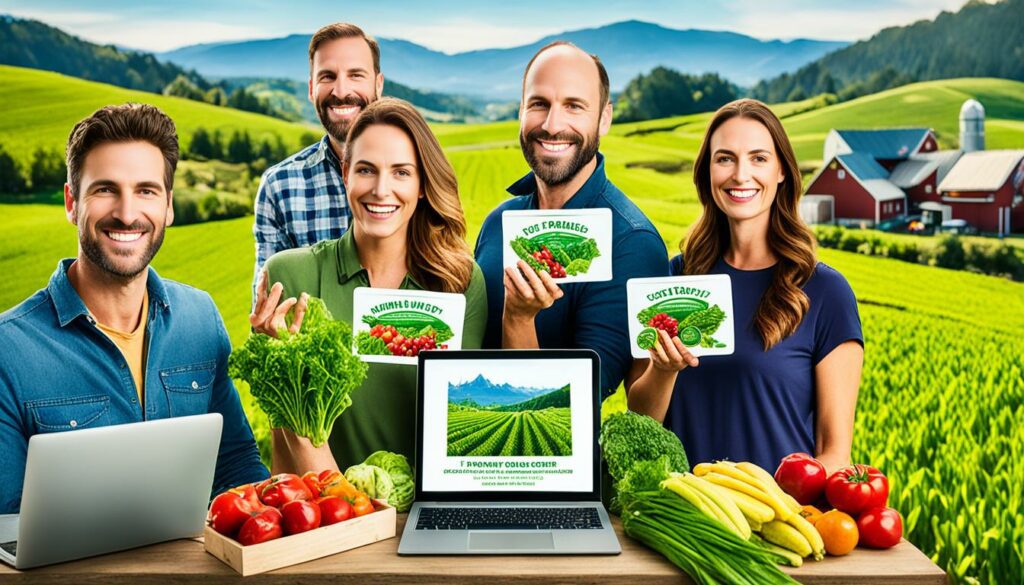
Marketing tactics should suit what you sell and who you sell to. Think about using social media, great websites, clear signs, helpful leaflets, or ads. Sticking to a simple plan can be cheap yet effective. Social media is free. Websites are cheap. But radio ads cost more yet might pay off.
Break the big market into smaller groups by age, money, where they live, and so on. This way, you can offer things just right for different people. Using tech helps in this smart targeting.
| Market Segmentation | Details |
|---|---|
| Age | Different age groups have varied preferences and spending habits. |
| Income | Income levels determine spending power and purchasing decisions. |
| Geographical Location | Location influences product availability and local preferences. |
| Lifestyle | Consumers’ lifestyles dictate their needs and desires. |
Get what your customers want by asking, watching, and learning. This helps make things and ads that really matter to them. And it gets them more involved with what you do.
Looking at the market means seeing who else is out there, where the gaps are, and why you’re different. Selling straight to people gets you closer to them and means better farming software use.
It’s crucial to plan your farm website’s structure well. This helps users find what they need easily. Including the right pages is key, making sure your site works smoothly.
Each page should show your farm’s unique character. Here are pages you must have:
Making your site easy to navigate is key. It keeps visitors happy and staying longer. Use clear menus and make important info just a click away. This is crucial for a good user experience.
Aim for a smooth browsing experience. When visitors find what they need easily, they’re more likely to come back. This boosts your business and makes your farm stand out online.
Setting up an online store for your farm needs a smart domain name. A name that’s easy to remember makes your brand stand out. With around 2 billion websites online, it’s key to be easily found. This makes a unique digital name very important.
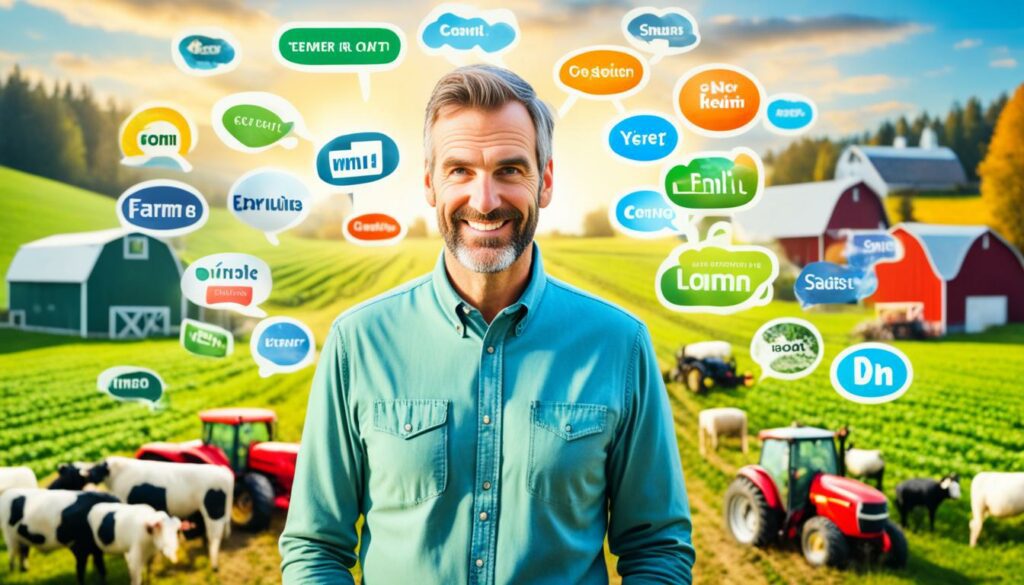
Creating a memorable domain name takes effort and creativity. Shorter names, between 6 and 14 characters, work best. They’re easy to remember and you’re less likely to make mistakes typing them.
Look at brands like eBay for inspiration. They chose a distinctive name that’s easy to remember. It helps a lot with your online visibility.
It’s also good to own different domain types, like .com or .org. This can protect your brand. Tools like Google Keyword Planner can help you pick better words for searches. This boosts your SEO, making it easier for people to find your site.
Your domain name can show where your farm is, boosting its online visibility. For example, using .co.uk shows you’re in the UK. But, think about the cost to renew these special domains.
Don’t pick names too close to famous brands to avoid problems. And, check for trademarks to keep your brand safe. The .com domain remains a favourite because it’s so common online.
By being creative and practical, your farm’s presence online can really grow. Knowing these tips helps your domain name strategy work for your farm for the long run.
Choosing the best website builder is key for farms wanting a strong online presence. With the right choice, farms can increase sales by 50% through online channels.
For small businesses, being online is crucial today. Especially since 75% of those that do well in face-to-face sales use websites and social media to grow.
Look for features such as easy product displays, safe payment methods, and tools for farm management. No-code solutions are great for those who don’t know how to code. They offer flexibility and are easy to use.
Most farms choose platforms directly catered to farming, over general ones. Specialised options, like Local Line, are made for selling farm goods. They offer unique features and may have lower fees, from 1.5% to 4% per sale.
Farm-specific builder costs average between $20 and $50 monthly, not too steep. Adding other apps can run from $10 to $30 each. These chosen platforms often lead to 30% more sales, signifying their value.
To help you choose, here’s a table comparing website builder types:
| Feature | Farm-Specific Builder | General E-commerce |
|---|---|---|
| Monthly Pricing | $20 – $50 | $30 – $60 |
| Transaction Fees | 1.5% – 4% | 2% – 5% |
| Number of Features | 10+ | 15+ |
| Customisation Options | 60% | 70% |
| Specialised Support | Yes | No |
Thinking about your farm’s specific needs will guide you well. Be it a template-driven design or no-code system, choosing wisely means more visibility and sales.
When you make a website for a farm, you need to think carefully. It’s about using great visuals and making sure the site looks good on phones. Doing this helps people enjoy their visit and want to come back.
Adding high-quality farm imagery and videos makes your site more interesting. These materials show your farm’s real beauty and make visitors feel connected. Good pictures and videos not only attract people but also tell the story of your farm. This can make them want to visit again and again.

Many people visit websites on their mobile phones. So, making sure your site looks good on all devices is very important. If your site works well on phones, people will have a good experience. They’ll stay longer and may buy things from you. Making your site mobile-friendly is a must these days.
Use these engaging website aesthetics ideas to show off your farm’s excitement. This will not only draw people in but also make them want to support your farm.
Adding e-commerce to your farm’s site is key for a better customer journey. It helps make buying easy by showing products clearly and smooth transactions. This is how you make sales online more effective.
Online retail has massively grown, with U.S. e-commerce sales up 2,882% between 1999 and 2019. More U.S. homes use online grocery shops now, showing a chance for farms to sell online.
Write great product descriptions and use good photos. Make sure the checkout is easy and the payment process works well. Here’s a look at popular e-commerce platforms fit for farm use:
| Platform | Monthly Cost | Transaction Fees | Special Features |
|---|---|---|---|
| Square | $0 to $79 | 2.9% + $0.30 | Simple setup, integrated POS |
| Grazecart | $149 to $399 | Varies | Best for variable weight products |
| Woocommerce | Varies | 2.9% + $0.30 | High customisation options, flexible tools |
| Shopify | $29 to $299 | 2.9% + $0.30 | Suitable for large product catalogues |
| Squarespace | $27 to $49 | Varies | Beautiful templates, integrated marketing tools |
Choosing the right e-commerce platform is crucial. It could be about costs, special features, or how easy it is to set up. The goal is to increase sales and keep customers happy.
Selling farm products online? Showing your items well matters a lot. Great photos are key. Use a DSLR camera for pictures that stand out. It captures the true look of your products better than old digital cameras or phones can. A natural setting makes your products look more real. This makes customers trust your farm more.
Make sure there are no shadows in your photos. Change where you take the picture to get rid of shadows. This makes your products look their best. You can use other sites for photos, but it’s better to show your own items. It helps your customers feel a real connection. Bad photos can make your farm look bad and slow sales.
Sorting your products well online is very important. It helps customers find what they want easily. Write about what makes your farm special. Talk about things like using organic methods and making sure your products are the best quality. This helps your customers understand why your farm is great.
Think about how stores are set up when you place your products. Putting tempting items near the checkout can boost your sales. Keep fresh items cold to keep them good longer. This makes customers happy and more likely to buy from you again.
“A careful consideration of intuitive catalogues and compelling product presentation can transform casual browsers into loyal customers.”
Make it easy for customers to learn about your products. They can ask for samples or see and smell the products up close. Having clear signs about prices and features helps a lot too. This encourages people to buy more.
| Product Display Tip | Impact on Sales |
|---|---|
| High-Quality Photos | Increases Trust and Appeal |
| Use of Natural Scenery | Enhances Authenticity |
| Stock Photos | Should be Avoided if Possible |
| Cool Temperature Display | Preserves Product Quality |
| Impulse Buy Placement | Increases Sales Opportunities |
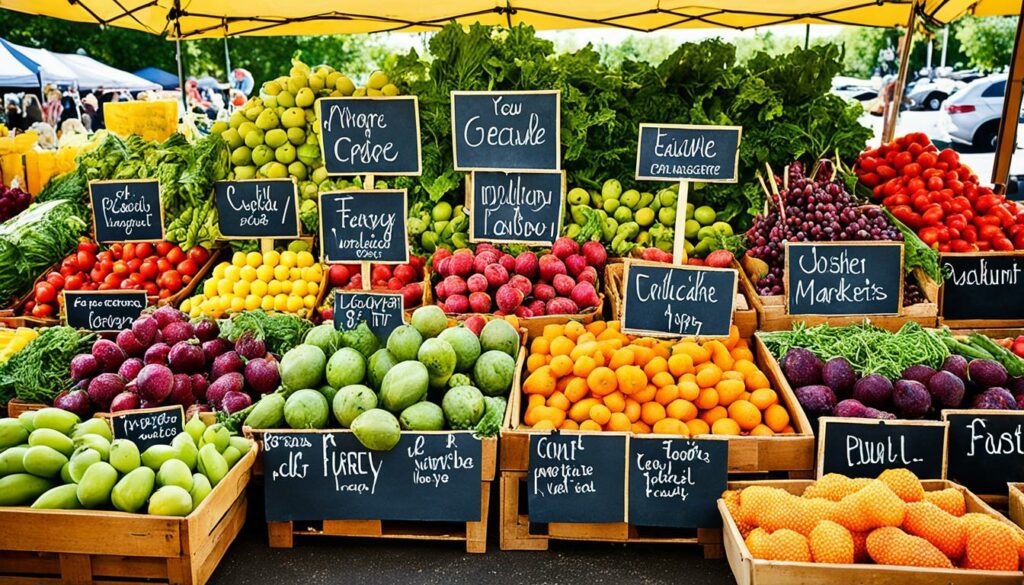
Improving your farm’s website for search engines is very important. This is because 93% of people start their online journey with a search. By using good SEO techniques, you can get more people visiting your site. This means more traffic and potential leads for your business.
To do good SEO for the agriculture sector, you need to do a few things. First, use keywords that help you rank better in searches. Then, make interesting stuff like blogs, infographics, and videos that people will want to see. WebFX, a top digital marketing firm, says doing this and picking the right keywords is key to getting more views and a better search spot.
How your website feels for users matters a lot for SEO too. Things like beautiful pictures, easy to use menus, and content that matches what people search for can help a lot. Make sure your titles and descriptions match what you offer. This helps people decide to click on your site when they see it in search results.
Local SEO for farms is really important. This means using tactics that bring in people nearby, like geofencing. Doing this helps your farm get more local attention through online searches.
A good local SEO means more people visiting your farm and who are interested in what you offer. This could turn them into loyal customers as they find you more easily in local searches.
Working on these strategies can really help your farm’s website do better in searches. This could mean more people visiting, more leads, and a boost in sales.
| Strategy | Impact | Example |
|---|---|---|
| Keyword Integration | Higher organic search ranking | Using phrases like “organic farm produce” in blog posts |
| User Experience | Increased dwell time and lower bounce rate | Simple navigation and high-quality images |
| Local SEO | Improved local traffic and engagement | Geofencing within a 4-5 mile radius |
| Content Creation | Higher user interaction and backlinks | Regular blogs, videos, and infographics |
Social media can boost your farm’s online presence and draw in more visitors. It opens up a chance to reach over 3.5 billion users. Using social media right can truly improve your digital marketing. This leads to better results.

Linking your farm’s website to social media is key for growth. Add clickable icons for easy navigation. Letting visitors share content will spread your message further.
But, it’s more than just sharing links. Ads that track interested users back to your site can greatly improve sales. Also, using lead forms on platforms like LinkedIn can boost conversion rates. This beats traditional ways of getting people to visit.
Quality content is vital for good social media. Use beautiful, relevant images of your farm to connect with people. This boosts engagement and builds a closer link with your customers.
Try new ways to market. For example, referral campaigns can increase your leads. Webinars are great for getting more contacts and sales. Think about hosting online events too. They show expertise and gather important customer info.
Offering free tools or discounts can make visitors more willing to share their details. This supports continued interaction and more sales. Remember, social media is about more than just posting. Being active in discussions can lead to finding new customers and building strong relationships.
These strategies can significantly increase your website traffic. This transforms your social media into powerful tools for your farm’s growth and better customer ties.
Creating an online store for your farm means following key online store best practices. It’s important that your site works well on mobile phones and tablets. More and more people use their devices to shop online. Being mobile-friendly helps reach these customers, with 37% preferring mobile wallets.
It’s crucial to keep your branding consistent. Most shoppers click on products shown on the first page. The top three items get 60% of the sales. So, putting your most popular products at the top can really increase your sales.
Sending automated emails about orders is also important. This keeps customers interested and coming back. Using subscriptions can be a big win too. For example, top farmers on Barn2Door make over 80% of their money this way.
Think about the costs of running an online shop, like monthly fees and transaction fees. It’s key to choose the right plan for the amount of traffic you expect. Features such as personalised pick-up and delivery times are very helpful. They can make running the store smoother, especially for selling food and farm goods.
Doing pre-sales can bring in money before the harvest. This creates excitement among customers. It’s also smart to block out time for holidays, so your business doesn’t clash with family time. By following these tips, and keeping in mind your long-term goals, you can make sure your online store is a success.
| Consideration | Importance |
|---|---|
| Mobile Flexibility | High |
| Consistent Branding | Critical |
| Subscription Models | Highly Effective |
| Payment Methods | Flexible |
To wrap up, sticking to these online store best practices and making your site better for shoppers can lead to more sales. This can help grow your business and make everything run more smoothly.
When you set up an online farm shop, it’s key to offer different ways for customers to get their goods. This can make them happier and sell more stuff. Think about using things like home delivery, letting them pick up, or smart shipping for a variety of needs.
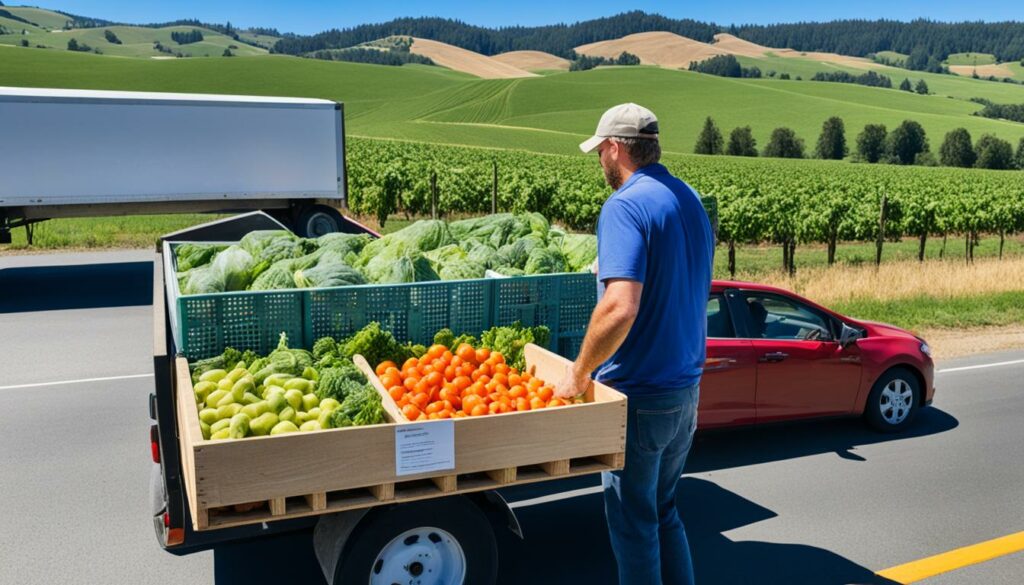
Getting produce delivered ensures it’s fresh and quick for your customers. Services such as GrazeCart, Shopify, and Square help farmers run smooth local deliveries. GrazeCart joins with ShipFare to get good shipping prices, keeping costs down for sending out produce.
Think about letting customers pick up their orders from your farm. This makes it easier for them and builds a direct link. GrazeCart and Square help by setting up pick-up spots, saving on delivery costs and keeping everything fresh.
For buyers further away, good shipping choices are a must. Platforms like GrazeCart, Shopify, and Square let you set up different shipping zones. GrazeCart’s deal with ShipFare means you get good shipping deals, especially for lots of products.
| Feature | GrazeCart | Shopify | Square |
|---|---|---|---|
| Local Delivery | Available | Available | Available |
| Local Pick-Up | Available | Available | Available |
| Shipping Options | ShipFare Integration | Built-in | Built-in |
| Geo Zone Pricing | Yes | Yes | Yes |
Creating a farm store online needs smart planning and a focus on customers. In 2012, local and regional food sales reached $6.1 billion, showing a big market. This guide helps with important steps, like finding your audience and making your site liked by search engines. This way, your online store can be strong and interesting, leading to growth and happy customers.
There was a 20% drop in new farmers from 2007 to 2012. This shows we need new ideas, like online stores, to support farming that can last. Schools in the US are getting food locally, with 44% having school farm programs. This creates a bigger demand for online farm stores.
Food hubs help farmers a lot by gathering, storing, and selling their goods. States like Georgia have shown how this teamwork helps farmers sell more. It also lets them make more money by turning their goods into special products. This way, farmers can do better online and support e-commerce and eco-friendly farming.
Starting an online farm store is more than just a business. It helps promote local food and a better way to farm. By using this guide, you can make a successful online shop. It will make customers happy and bring growth. If you want to learn more about good local food systems, check out farm to table initiatives.
Setting up an online store for your farm has many benefits. It boosts your exposure and increases sales. It lets you reach a wider customer base.
Direct selling from the farm also helps. It makes it easier for consumers to buy from you. This builds brand loyalty.
Having a farm online makes it easier for people to find you. It increases your chance of interacting with users. This, in turn, drives more people to your online shop.
It also helps more people to know about your brand.
Think about your website’s main goal. It could be to talk about your farming practices or to sell your products. Know what matters to your target audience.
Use content, pictures, and features they like. This gets them interested in what you offer.
Include pages like “Home,” “About Us,” “How to Shop,” and “FAQs”. They guide visitors and make their visit better. A well-organised website keeps them coming back and buying more.
A good domain name is like a great first impression. It helps people remember you. It also tells them where you are, attracting those nearby to your farm.
Pick a website builder that’s easy to use and fits your farm’s needs. Both no-code and custom design tools are good. They help create a unique and effective website.
Many people use their phones to browse the web. Making your site mobile-friendly is a must. It improves how users experience your website, keeping them satisfied.
SEO can really help people find your farm online. Use the right keywords and create relevant content. Also, focus on local SEO. This gets you seen by people in your area.
Social media is great for sharing content and connecting with people. Linking it with your website boosts your site’s popularity. This can lead to more visitors and sales.
For a successful online store, keep the look and message consistent. Design a site that’s easy to use. Clear communication is key. These steps pave the way for success.
Give customers choices like delivery, local pick-up, and different shipping methods. Meeting their preferences makes shopping with you great. It also improves their overall experience.